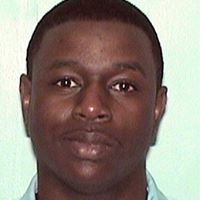Charles N Alexander
age ~85
from Boise, ID
- Also known as:
-
- Charles Steven Alexander
- Charles S Alexander
- Charles A Alexander
- Steve N Alexander
- Steve S Alexander
- Steve E Alexander
- Charles N Alexnader
- Phone and address:
-
4713 S Rawhide Ave, Boise, ID 83709
2083627865
Charles Alexander Phones & Addresses
- 4713 S Rawhide Ave, Boise, ID 83709 • 2083627865
- Moscow, ID
- Nampa, ID
- Twin Falls, ID
Work
-
Company:Ahern rentalsSep 2009
-
Position:Branch and customer service manager
Education
-
School / High School:Dale Carnegie2000
-
Specialities:Business and Self
Us Patents
-
System And Method For Aligning Output Signals In Massively Parallel Testers And Other Electronic Devices
view source -
US Patent:6430725, Aug 6, 2002
-
Filed:Jun 22, 2000
-
Appl. No.:09/602203
-
Inventors:David A. Reichle - Boise ID
Charles K. Snodgrass - Boise ID
Charles S. Alexander - Boise ID
Fremont S. Smith - Boise ID -
Assignee:Micron Technology, Inc. - Boise ID
-
International Classification:G06F 1100
-
US Classification:714815, 714700, 714724, 714736, 327261, 713503
-
Abstract:Signal alignment circuitry aligns (i e. , deskews) test signals from a massively parallel tester. A timing portion of each signal is received by a rising edge delay element, a falling edge delay element, and a transition detector, all in parallel. The delay of the rising edge and falling edge delay elements is independently controlled by control circuitry. The outputs of the rising edge and falling edge delay elements are muxed together, and the output of the mux is selected in response to rising edge and falling edge transitions detected by the transition detector. The output of the mux is provided to pulse generating circuitry, which generates a pulse at each edge for use in clocking a data portion of each signal into a DQ flip-flop. The output of this DQ flip-flop is then latched in to another DQ flip-flop by a reference clock. To control the rising and falling edges of one of the test signals, and thereby align the signal with the other test signals, the control circuitry first sweeps the delay in the rising edge and falling edge delay elements until the latched-in signal transitions.
-
Circuitry For And System And Substrate With Circuitry For Aligning Output Signals In Massively Parallel Testers And Other Electronic Devices
view source -
US Patent:6754861, Jun 22, 2004
-
Filed:Jun 6, 2002
-
Appl. No.:10/164975
-
Inventors:David A. Reichle - Boise ID
Charles K. Snodgrass - Boise ID
Charles S. Alexander - Boise ID
Fremont S. Smith - Boise ID -
Assignee:Micron Technology, Inc. - Boise ID
-
International Classification:G06F 1100
-
US Classification:714724, 714700, 714736, 714815, 327261, 713503
-
Abstract:Signal alignment circuitry aligns (i. e. , deskews) test signals from a massively parallel tester. A timing portion of each signal is received by a rising edge delay element, a falling edge delay element, and a transition detector, all in parallel. The delay of the rising edge and falling edge delay elements is independently controlled by control circuitry. The outputs of the rising edge and falling edge delay elements are muxed together, and the output of the mux is selected in response to rising edge and falling edge transitions detected by the transition detector. The output of the mux is provided to pulse generating circuitry, which generates a pulse at each edge for use in clocking a data portion of each signal into a DQ flip-flop. The output of this DQ flip-flop is then latched in to another DQ flip-flop by a reference clock.
-
System And Method For Aligning Output Signals In Massively Parallel Testers And Other Electronic Devices
view source -
US Patent:61580309, Dec 5, 2000
-
Filed:Aug 21, 1998
-
Appl. No.:9/137738
-
Inventors:David A. Reichle - Boise ID
Charles K. Snodgrass - Boise ID
Charles S. Alexander - Boise ID
Fremont S. Smith - Boise ID -
Assignee:Micron Technology, Inc. - Boise ID
-
International Classification:G01R 3128
-
US Classification:714724
-
Abstract:Signal alignment circuitry aligns (i. e. , deskews) test signals from a massively parallel tester. A timing portion of each signal is received by a rising edge delay element, a falling edge delay element, and a transition detector, all in parallel. The delay of the rising edge and falling edge delay elements is independently controlled by control circuitry. The outputs of the rising edge and falling edge delay elements are muxed together, and the output of the flux is selected in response to rising edge and falling edge transitions detected by the transition detector. The output of the mux is provided to pulse generating circuitry, which generates a pulse at each edge for use in clocking a data portion of each signal into a DQ flip-flop. The output of this DQ flip-flop is then latched in to another DQ flip-flop by a reference clock. To control the rising and falling edges of one of the test signals, and thereby align the signal with the other test signals, the control circuitry first sweeps the delay in the rising edge and falling edge delay elements until the latched-in signal transitions.
-
Method And Apparatus For Signal Routing To Achieve Signal-Efficiency
view source -
US Patent:60615095, May 9, 2000
-
Filed:Jun 19, 1998
-
Appl. No.:9/100440
-
Inventors:Charles K. Snodgrass - Boise ID
Robert L. Totorica - Boise ID
David A. Reichle - Boise ID
Charles S. Alexander - Boise ID -
Assignee:Micron Technology, Inc. - Boise ID
-
International Classification:G06F 1750
-
US Classification:39550013
-
Abstract:The present invention provides for a method and an apparatus for routing electrical signals. The method includes accessing a plurality of electrical circuits. The apparatus includes a supervisory circuit capable of delivering two access signals from a group of first, second, third, and fourth access signals, wherein the supervisory circuit is capable of delivering one of the first and third access signals, and one of the second and fourth access signals. A plurality of electrical circuits is organized into first and second rows. A first portion of the plurality of electrical circuits in the first and second rows, is coupled to a first access signal line. A second portion of the plurality of electrical circuits in the first and second rows is coupled to a second access signal line. The first and second portions of the plurality of electrical circuits in said first row are coupled to a third access signal. The first and second portions of said plurality of electrical circuits in the second row are coupled to a fourth access signal.
Medicine Doctors

Charles H. Alexander
view sourceSpecialties:
Orthopaedic Surgery, Orthopedic Sports Medicine
Work:
Montebello Orthopedic Medical Group
6758 Passons Blvd, Pico Rivera, CA 90660
5626546899 (phone), 5626546895 (fax)
6758 Passons Blvd, Pico Rivera, CA 90660
5626546899 (phone), 5626546895 (fax)
Education:
Medical School
New York Medical College
Graduated: 1972
New York Medical College
Graduated: 1972
Procedures:
Arthrocentesis
Carpal Tunnel Decompression
Hallux Valgus Repair
Hip Replacement
Hip/Femur Fractures and Dislocations
Joint Arthroscopy
Knee Arthroscopy
Knee Replacement
Lower Arm/Elbow/Wrist Fractures and Dislocations
Shoulder Surgery
Carpal Tunnel Decompression
Hallux Valgus Repair
Hip Replacement
Hip/Femur Fractures and Dislocations
Joint Arthroscopy
Knee Arthroscopy
Knee Replacement
Lower Arm/Elbow/Wrist Fractures and Dislocations
Shoulder Surgery
Conditions:
Internal Derangement of Knee
Internal Derangement of Knee Ligaments
Intervertebral Disc Degeneration
Plantar Fascitis
Sciatica
Internal Derangement of Knee Ligaments
Intervertebral Disc Degeneration
Plantar Fascitis
Sciatica
Languages:
English
Korean
Spanish
Korean
Spanish
Description:
Dr. Alexander graduated from the New York Medical College in 1972. He works in Pico Rivera, CA and specializes in Orthopaedic Surgery and Orthopedic Sports Medicine. Dr. Alexander is affiliated with Beverly Hospital, St Vincent Medical Center and White Memorial Medical Center.

Charles P. Alexander
view sourceSpecialties:
Psychiatry
Work:
Southwest Community Health Center
1046 Fairfield Ave, Bridgeport, CT 06605
2033306054 (phone), 2033314716 (fax)
1046 Fairfield Ave, Bridgeport, CT 06605
2033306054 (phone), 2033314716 (fax)
Education:
Medical School
New York Medical College
Graduated: 1977
New York Medical College
Graduated: 1977
Conditions:
Anxiety Dissociative and Somatoform Disorders
Anxiety Phobic Disorders
Attention Deficit Disorder (ADD)
Bipolar Disorder
Depressive Disorders
Anxiety Phobic Disorders
Attention Deficit Disorder (ADD)
Bipolar Disorder
Depressive Disorders
Languages:
English
Spanish
Spanish
Description:
Dr. Alexander graduated from the New York Medical College in 1977. He works in Bridgeport, CT and specializes in Psychiatry. Dr. Alexander is affiliated with Greater Bridgeport Community Mental Health Center.

Charles B. Alexander
view sourceSpecialties:
Anatomic Pathology & Clinical Pathology
Work:
University Of Alabama Birmingham Pathology
619 19 St S, Birmingham, AL 35249
2059344303 (phone), 2059345499 (fax)
619 19 St S, Birmingham, AL 35249
2059344303 (phone), 2059345499 (fax)
Education:
Medical School
University of Virginia School of Medicine
Graduated: 1971
University of Virginia School of Medicine
Graduated: 1971
Languages:
English
Description:
Dr. Alexander graduated from the University of Virginia School of Medicine in 1971. He works in Birmingham, AL and specializes in Anatomic Pathology & Clinical Pathology. Dr. Alexander is affiliated with University Of Alabama Hospital.

Charles M. Alexander
view sourceSpecialties:
Ophthalmology
Work:
Mielcarek Eye AssociatesMielcarek Eye Lifetime Vision Center
319 W State St, Media, PA 19063
6105661227 (phone)
319 W State St, Media, PA 19063
6105661227 (phone)
Languages:
English
Spanish
Spanish
Description:
Dr. Alexander works in Media, PA and specializes in Ophthalmology. Dr. Alexander is affiliated with Crozer Chester Medical Center and Riddle Hospital.

Charles Michael Alexander
view sourceSpecialties:
Internal Medicine
Endocrinology and Metabolism
Endocrinology, Diabetes & Metabolism
Endocrinology and Metabolism
Endocrinology, Diabetes & Metabolism
Education:
University of Southern California(1977)

Charles P Alexander
view sourceSpecialties:
Psychiatry
Child & Adolescent Psychiatry
Child Psychiatry
Child & Adolescent Psychiatry
Child Psychiatry
Education:
New York Medical College (1977)

Charles Dale Alexander
view sourceSpecialties:
Family Medicine
Education:
The University of Texas Southwestern (1968)
Wikipedia References

Charles Alexander (Defensive Tackle)

Charles Alexander (Poet)

Charles Alexander (Running Back)
Name / Title
Company / Classification
Phones & Addresses
Director
Chax Press, Inc
Deputy Administrator, Office Of Country And Region, Administrative Assistant
Foreign Agricultural Service
Develop & Service Foreign Markets · Agricultural Services · Regulation Agricultural Marketing
Develop & Service Foreign Markets · Agricultural Services · Regulation Agricultural Marketing
2027203935, 2026901924, 2027206713, 2027206343
Chaplain
Dumas Post No. 9022, Veterans of Foreign Wars of The United States, Dumas, Texas
MARILYN WALLACE LLC
SPRINGFIELD A&E PROPERTIES LLC
Director
Builders Bank
National Commercial Bank
National Commercial Bank
3127509300
Director
AFRICAN AMERICAN HISTORICAL SOCIETY OF ALASKA
Secretary,Treasurer
ALEXANDER FARMS, INC
Vehicle Records
-
Charles Alexander
view source -
Address:2010 S Grassmere St, Boise, ID 83709
-
VIN:JTMBK32V575023865
-
Make:TOYOTA
-
Model:RAV4
-
Year:2007
Isbn (Books And Publications)

Problems Solving Made Almost Easy: A Companion To Fundamentals Of Electric Circuits
view sourceAuthor
Charles Alexander
ISBN #
0072463384







Masters of Jazz Guitar: The Story of the Players and Their Music
view sourceAuthor
Charles Alexander
ISBN #
0879305924
Resumes

Charles Alexander Daisy, TN
view sourceWork:
Ahern Rentals
Sep 2009 to Dec 2010
Branch and Customer Service Manager Briggs Construction Equipment
Dec 2003 to Sep 2009
Parts Manager TSA
Oct 2001 to Dec 2003
Security Technician Bobcat of Chattanooga
Jun 2000 to Oct 2001
General Parts Manager Clarklift Corporation
Feb 1989 to May 2000
General Parts Manager / Procurement Manager Brungart Corporation
May 1987 to Jan 1989
Customer Service Representative
Sep 2009 to Dec 2010
Branch and Customer Service Manager Briggs Construction Equipment
Dec 2003 to Sep 2009
Parts Manager TSA
Oct 2001 to Dec 2003
Security Technician Bobcat of Chattanooga
Jun 2000 to Oct 2001
General Parts Manager Clarklift Corporation
Feb 1989 to May 2000
General Parts Manager / Procurement Manager Brungart Corporation
May 1987 to Jan 1989
Customer Service Representative
Education:
Dale Carnegie
2000
Business and Self Soddy Daisy High School
1980
Logistics and Inventory Control
2000
Business and Self Soddy Daisy High School
1980
Logistics and Inventory Control
Lawyers & Attorneys

Charles Alexander - Lawyer
view sourceSpecialties:
Corporate Law
ISLN:
917589858
Admitted:
1980
Law School:
University of Kent at Canterbury, J.D.

Charles Alexander - Lawyer
view sourceOffice:
Cicero, France & Alexander, P.C.
Specialties:
Family Law
Divorce
Child Custody
Child Support
Civil Litigation
Insurance Defense
Personal Injury
General Practice
Divorce
Child Custody
Child Support
Civil Litigation
Insurance Defense
Personal Injury
General Practice
ISLN:
913050321
Admitted:
1993
University:
University of Illinois, B.S., 1990
Law School:
Northern Illinois University, J.D., 1993

Charles Alexander - Lawyer
view sourceSpecialties:
Legal Department Management
Marketing Distribution
Human Resources
Antitrust Law
Arbitration
Advertising
Marketing Distribution
Human Resources
Antitrust Law
Arbitration
Advertising
ISLN:
909501806
Admitted:
1986
University:
Cornell University, A.B., 1982
Law School:
State University of New York at Buffalo, J.D., 1985
License Records
Charles E Alexander
License #:
8488 - Expired
Expiration Date:
Dec 31, 2014
Type:
Master Technician
Charles H Alexander
License #:
NHTP-503 - Expired
Category:
Real Estate Appraiser
Type:
Temporary Practice Permit
Charles H Alexander
License #:
NHTP-428 - Expired
Category:
Real Estate Appraiser
Type:
Temporary Practice Permit
Charles H Alexander
License #:
NHTP-571 - Expired
Category:
Real Estate Appraiser
Type:
Temporary Practice Permit
Charles Ramsey Alexander
License #:
022640-21 - Expired
Category:
Nursing
Type:
Registered Nurse
Charles Ramsey Alexander
License #:
022640-23-11 - Expired
Category:
Nursing
Issued Date:
Dec 29, 1993
Expiration Date:
Aug 1, 1996
Type:
APRN-CRNA
Charles T. Alexander
License #:
- Expired
Category:
Optometry
Issued Date:
Mar 1, 1950
Youtube
Plaxo

Charles Alexander
view sourceProduct Design Engineering Manger at TiVo Inc. Hewlett-Packard- 8
Acuson- 3
SGI- 8
TiVo- 5...

CHARLES ALEXANDER
view sourceDenver, COPresident/CEO at Christian Transition Industries L...

CHARLES ALEXANDER
view sourcePRESIDENT at ALEXANDER REAL ESTATE

Charles Alexander
view sourceM.D. at Arpadis Southern Africa(pty) Ltd

Charles Alexander
view sourceExec Director at Chax Press

Charles Alexander
view sourceTimothy J Norris Associates

Charles Alexander
view sourceVerizon
Classmates

Charles Alexander
view sourceSchools:
McCluer Academy Jackson MS 1980-1984
Community:
Karen Sims, Gail Flemmons, Annette Acy, David Hancock

Charles Alexander
view sourceSchools:
Tolleston High School Gary IN 1962-1966
Community:
Anita Sakes, Jacqueline Magee, Lionel Rockey, Ezzard Donahue, Reginald Marcus

Charles Alexanedr (Alexan...
view sourceSchools:
King & Queen Central High School King VA 2004-2008
Community:
Nateska Andrews

Charles Alexander (Harn)
view sourceSchools:
McCluer Academy Jackson MS 1980-1984, Clinton High School Clinton MS 1982-1986
Community:
Danny Sims

Charles Alexander
view sourceSchools:
Beulah Hubbard High School Little Rock MS 1978-1982
Community:
Henry Walker, Henry Munn, Marsha Alexander, Steve Bond, Joseph Deen, Linda Hudson

Charles Alexander
view sourceSchools:
Morton Memorial High School Knightstown IN 1935-1939
Community:
Susan Jackson, Tony Davis, Ray Grooms, Clara Mullett

Charles Alexander
view sourceSchools:
Mendenhall High School Mendenhall MS 2002-2006
Community:
Bruce Willis

Charles Alexander
view sourceSchools:
Washington High School Tuskegee AL 1993-1997
Flickr
Googleplus

Charles Alexander
Work:
Speak HOPE, Inc. - Motivational Speaker (2011)
Arthur Agency - PR Specialist (2011-2011)
Arthur Agency - PR Specialist (2011-2011)
Education:
Southern Illinois University Carbondale - Speech Comm (Masters)
About:
Charles P. Alexander is the founder of Speak HOPE, Inc. This motivational speaking movement focuses mainly on the empowerment of minorities, with an emphasis on African American males. Speak HOPE is h...
Tagline:
Focused on dreams beyond my current circumstance. Follow my org @SPEAKHOPE_. Thanks.

Charles Alexander
Education:
Northwest Secondary School

Charles Alexander
About:
There is a well-known and anticipated moment during every Charles Alexander Recording when the keyboards discreetly takes the lead to bring out some amazing original sounds with Well written lyrics an...

Charles Alexander

Charles Alexander

Charles Alexander

Charles Alexander

Charles Alexander

Charles Cortez Alexander
view source
Charles Tillian Alexander
view source
Charles Emery Alexander
view source
Charles Alexander
view source
Charles L. Alexander Jr.
view source
Charles E. Alexander Jr.
view source
Charles Alexander Forbes
view source
Charles BigScooby Alexander
view sourceGet Report for Charles N Alexander from Boise, ID, age ~85













